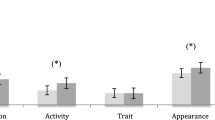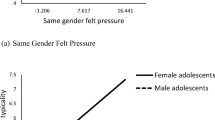Abstract
In the current research we provide initial documentation of the motivational content of gender stereotypes. Drawing from regulatory focus theory (Higgins, 1987, 1997), we distinguish between whether traits are perceived to be motivated by ideals, including hopes, dreams, and aspirations, and oughts, including responsibilities, duties, and obligations. In two studies of U.S. Midwestern undergraduates, participants rated the extent to which the traits of men or women are motivated by ideals or oughts. Study 1 included 137 introductory psychology students who rated gender stereotypic traits (e.g., competitiveness for men; sensitivity for women); Study 2 included 118 introductory psychology students who rated gender stereotypic or counterstereotypic traits (e.g., competitiveness for women; sensitivity for men). In both Studies 1 and 2, we demonstrate that people perceive women as especially motivated by ideals rather than oughts but men as equivalently motivated by ideals and oughts. These patterns emerge regardless of trait stereotypicality. In Study 3, we examined the relationship between perceptions of role flexibility and the perception of ideal motivation using a sample of 214 introductory psychology students from the Midwestern U.S. We found evidence that ascriptions of ideal motivation are associated with perceptions of role flexibility, which are greater for women. We discuss the implications of these beliefs for the legitimization of the existing gendered social system.



Similar content being viewed by others
References
Allport, G. W. (1954/1979). The nature of prejudice. Cambridge: Perseus Books.
Bakeman, R. (2005). Recommended effect size statistics for repeated measures designs. Behavior Research Methods, 37, 379–384. doi:10.3758/BF03192707.
Banchefsky, S., Diekman, A., Johnston, A. (2013). Achieving equality vs. avoiding discrimination: Using regulatory framing to affect attitudes. Poster presented at the 2013 meeting of the Society for Personality and Social Psychology, New Orleans, LA.
Bianchi, S. M. (2011). Family change and time allocation in American families. Annals of the American Academy of Political and Social Science, 638, 21–44. doi:10.1177/0002716211413731.
Bianchi, S. M., Milkie, M. A., Sayer, L. C., & Robinson, J. P. (2000). Is anyone doing the housework? Trends in the gender division of household labor. Social Forces, 79, 191–228. doi:10.2307/2675569.
Bianchi, S. M., Milkie, M. A., Sayer, L. C., & Robinson, J. P. (2012). Housework: Who did, does or will do it, and how much does it matter? Social Forces, 91, 55–63. doi:10.1093/sf/sos120.
Brescoll, V., & LaFrance, M. (2004). The correlates and consequences of newspaper reports of research on sex differences. Psychological Science, 15, 515–520. doi:10.1111/j.0956-7976.2004.00712.x.
Brescoll, V. L., Uhlman, E. L., & Newman, G. E. (2013). The effects of system-justifying motives on endorsement of essentialist explanations for gender differences. Journal of Personality and Social Psychology, 105, 891–908. doi:10.1037/a0034701.
Broverman, I. K., Vogel, S. R., Broverman, D. M., Clarkson, F., & Rosenkrantz, P. S. (1972). Sex-role stereotypes: A current appraisal. Journal of Social Issues, 28, 59–78. doi:10.1111/j.1540-4560.1972.tb00018.x.
Center for American Women and Politics. (2015). Women in elective office 2015: Fact Sheet. New Brunswick: Rutgers. Retrieved from http://www.cawp.rutgers.edu/fast_facts/levels_of_office/documents/elective.pdf.
Croft, A., Schmader, T., & Block, K. (2015). An underexamined inequality: Cultural and psychological barriers to men’s engagements with communal roles. Personality and Social Psychology Review. Advance online publication. doi:10.1177/1088868314564789.
Dar-Nimrod, I., & Heine, S. J. (2006). Exposure to scientific theories affects women’s math performance. Science, 314, 435. doi:10.1126/science.1131100.
Deaux, K., & Lewis, L. L. (1984). Structure of gender stereotypes: Interrelationships among components and gender label. Journal of Personality and Social Psychology, 46, 991–1004. doi:10.1037/0022-3514.46.5.991.
Diekman, A. B., & Eagly, A. H. (2000). Stereotypes as dynamic constructs: Women and men of the past, present, and future. Personality and Social Psychology Bulletin, 26, 1171–1188. doi:10.1177/0146167200262001.
Diekman, A. B., & Goodfriend, W. (2006). Rolling with the changes: A role congruity perspective on gender norms. Psychology of Women Quarterly, 30, 369–383. doi:10.1111/j.1471-6402.2006.00312.x.
Diekman, A. B., Eagly, A. H., & Kulesa, P. (2002). Accuracy and bias in stereotypes about the social and political attitudes of women and men. Journal of Experimental Social Psychology, 38, 268–282. doi:10.1006/jesp.2001.1511.
Diekman, A. B., Goodfriend, W., & Goodwin, S. (2004). Dynamic stereotypes of power: Perceived change and stability in gender hierarchies. Sex Roles, 50, 201–215. doi:10.1023/B:SERS.0000015552.22775.44.
Diekman, A. B., Eagly, A. H., Mladinic, A., & Ferreira, M. C. (2005). Dynamic stereotypes about women and men in Latin America and the United States. Journal of Cross-Cultural Psychology, 36, 209–226. doi:10.1177/0022022104272902.
Diekman, A. B., Eagly, A. H., & Johnston, A. M. (2010). Social structure. In J. F. Dovidio, M. Hewstone, P. Glick, & V. M. Esses (Eds.), The Sage handbook of prejudice, stereotyping, and discrimination (pp. 209–224). New York: Sage.
Eagly, A. H., & Diekman, A. B. (2003). The malleability of sex differences in response to changing social roles. In L. G. Aspinwall & U. M. Staudinger (Eds.), A psychology of human strengths: Fundamental questions and future directions for a positive psychology (pp. 103–115). Washington, D.C.: APA.
Eagly, A. H., & Kite, M. E. (1987). Are stereotypes of nationalities applied to both women and men? Journal of Personality and Social Psychology, 53, 451–462. doi:10.1037/0022-3514.53.3.451.
Eagly, A. H., & Mladinic, A. (1989). Gender stereotypes and attitudes toward women and men. Personality and Social Psychology Bulletin, 15, 543–558. doi:10.1177/0146167289154008.
Eagly, A. H., & Steffen, V. J. (1984). Gender stereotypes stem from the distribution of women and men into social roles. Journal of Personality and Social Psychology, 46, 735–754. doi:10.1037/0022-3514.46.4.735.
Eagly, A. H., Wood, W., & Diekman, A. B. (2000). Social role theory of sex differences and similarities: A current appraisal. In T. Eckes & H. M. Trautner (Eds.), The developmental social psychology of gender (pp. 123–174). Mahwah: Lawrence Erlbaum.
Fiske, S. T., Cuddy, A. J. C., Glick, P., & Xu, J. (2002). A model of (often mixed) stereotype content. Journal of Personality and Social Psychology, 82, 878–902. doi:10.1037/0022-3514.82.6.878.
Glick, P., & Fiske, S. T. (1996). The Ambivalent Sexism Inventory: Differentiating hostile and benevolent sexism. Journal of Personality and Social Psychology, 70, 491–512. doi:10.1037/0022-3514.70.3.491.
Glick, P., & Fiske, S. T. (2001). An ambivalent alliance: Hostile and benevolent sexism as complementary justifications for gender inequality. American Psychologist, 56, 109–118. doi:10.1037/0003-066X.56.2.109.
Goni-Legaz, S., Ollo-Lopez, A., & Bayo-Moriones, A. (2010). The division of household labor in Spanish dual earner couples: Testing three theories. Sex Roles, 53, 515–529. doi:10.1007/s11199-010-9840-0.
Hayes, A. F. (2013). Introduction to mediation, moderation, and conditional process analysis: A regression-based approach. New York: Guilford Press.
Higgins, E. T. (1987). Self-discrepancy: A theory relating self and affect. Psychological Review, 94, 319–340. doi:10.1037/0033-295X.94.3.319.
Higgins, E. T. (1997). Beyond pleasure and pain. American Psychologist, 52, 1280–1300. doi:10.1037/0003-066X.52.12.1280.
Higgins, E. T. (1998). Promotion and prevention: Regulatory focus as a motivational principle. Advances in Experimental Social Psychology, 30, 1–46. doi:10.1016/S0065-2601(08)60381-0.
Johnston, A. M., & Diekman, A. B. (2013, January). Perceiving desires, not duties: Believing women are ideally motivated legitimizes the existing system. In M. Williams (Chair), When and why women step back from status: The enduring and self-reinforcing power of traditional gender roles. Symposium conducted at the 2013 meeting of the Society for Personality and Social Psychology, New Orleans, LA.
Jost, J. T., & Banaji, M. R. (1994). The role of stereotyping in system-justification and the production of false consciousness. British Journal of Social Psychology, 33, 1–27. doi:10.1111/j.2044-8309.1994.tb01008.x.
Jost, J. T., & Kay, A. C. (2005). Exposure to benevolent sexism and complementary gender stereotypes: Consequences for specific and diffuse forms of system justification. Journal of Personality and Social Psychology, 88, 498–509. doi:10.1037/0022-3514.88.3.498.
Jost, J. T., Kivetz, Y., Rubini, M., Guermandi, G., & Mosso, C. (2005). System-justifying functions of complementary regional and ethnic stereotypes: Cross-national evidence. Social Justice Research, 18, 305–333. doi:10.1007/s11211-005-6827-z.
Kay, A. C., & Jost, J. T. (2003). Complementary justice: Effects of “poor but happy” and “poor but honest” stereotype exemplars on system justification and implicit activation of the justice motive. Journal of Personality and Social Psychology, 85, 823–837. doi:10.1037/0022-3514.85.5.823.
Lenton, A. P., Sedikides, C., & Bruder, M. (2009). A latent semantic analysis of gender stereotype-consistency and narrowness in American English. Sex Roles, 60, 269–278. doi:10.1007/s11199-008-9534-z.
Martin, C. L., & Parker, S. (1995). Folk theories about sex and race differences. Personality and Social Psychology Bulletin, 21, 45–57. doi:10.1177/0146167295211006.
Moss-Racusin, C. A., Phelan, J. E., & Rudman, L. A. (2010). When men break the gender rules: Status incongruity and backlash against modest men. Psychology of Men & Masculinity, 11, 140–151. doi:10.1037/a0018093.
Nolen-Hoeksema, S. (2001). Gender differences in depression. Current Directions in Psychological Science, 10, 173–176. doi:10.1111/1467-8721.00142.
Prentice, D. A., & Carranza, E. (2002). What women and men should be, shouldn’t be, are allowed to be, and don’t have to be: The contents of prescriptive gender stereotypes. Psychology of Women Quarterly, 26, 269–281. doi:10.1111/1471-6402.t01-1-00066.
Prentice, D. A., & Miller, D. T. (1996). Pluralistic ignorance and the perpetuation of social norms by unwitting actors. In M. P. Zanna (Ed.), Advances in experimental social psychology (Vol. 28, pp. 161–209). San Diego: Academic.
Rudman, L. A. (1998). Self-promotion as a risk factor for women: The costs and benefits of counterstereotypical impression management. Journal of Personality and Social Psychology, 74, 629–645. doi:10.1037/0022-3514.74.3.629.
Rudman, L. A., & Glick, P. (1999). Feminized management and backlash toward agentic women: The hidden costs to women of a kinder, gentler image of middle managers. Journal of Personality and Social Psychology, 77, 1004–1010. doi:10.1037/0022-3514.77.5.1004.
Rudman, L. A., & Goodwin, S. A. (2004). Gender differences in automatic ingroup bias: Why do women like women more than men like men? Journal of Personality and Social Psychology, 87, 494–509. doi:10.1037/0022-3514.87.4.494.
Rudman, L. A., Moss-Racusin, C. A., Phelan, J. E., & Nauts, S. (2012). Status incongruity and backlash effects: Defending the gender hierarchy motivates prejudice against female leaders. Journal of Experimental Social Psychology, 48, 165–179. doi:10.1016/j.jesp.2011.10.008.
Sayer, L. C., Bianchi, S. M., & Robinson, J. P. (2004). Are parents investing less in children? Trends in mothers’ and fathers’ time with children. American Journal of Sociology, 110, 1–43. doi:10.1086/386270.
Sczesny, S., Bosak, J., Neff, D., & Schyns, B. (2004). Gender stereotypes and the attribution of leadership traits: A cross-cultural comparison. Sex Roles, 51, 631–645. doi:10.1007/s11199-004-0715-0.
Twenge, J. M. (1997). Changes in masculine and feminine traits over time: A meta-analysis. Sex Roles, 36, 305–325. doi:10.1007/BF02766650.
U.S. Department of Labor. (2014). Women in the labor force: A databook (2014 ed., Report No. 1052). Washington, DC: U. S. Bureau of Labor Statistics.
Williams, J. E., & Best, D. L. (1990). Measuring sex stereotypes: A multination study. Thousand Oaks: Sage Publications.
Compliance with Ethical Standards
Conflicts of Interest
We have no conflicts of interest.
Informed Consent
All participants were required to sign an informed consent prior to participation.
Author information
Authors and Affiliations
Corresponding author
Appendix
Appendix
Scientific research has shown that some traits are perceived as normative for women, and that women report high levels of at least some of these traits. We are interested in why you think women tend to have these traits.
In particular, we want to know whether you think women have these traits because they ideally want them (they hope, wish, and aspire for them), because they feel they ought to have them (they feel a duty, obligation, and responsibility to have them), or both.
Please rate your opinion about the reasons for these different characteristics. Please rate both items under each trait. Make your mark in between the lines, as shown.

Rights and permissions
About this article
Cite this article
Johnston, A.M., Diekman, A.B. Pursuing Desires Rather Than Duties? The Motivational Content of Gender Stereotypes. Sex Roles 73, 16–28 (2015). https://doi.org/10.1007/s11199-015-0494-9
Published:
Issue Date:
DOI: https://doi.org/10.1007/s11199-015-0494-9




